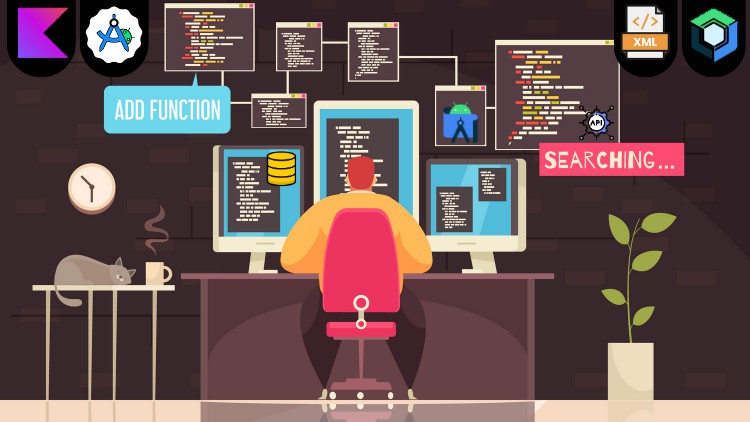Key Takeaways:
- Mobile app development has revolutionized the way we interact with technology.
- Developing mobile applications offers benefits for both individuals and businesses.
- iOS and Android are the two major mobile platforms dominating the market.
- Choosing the right development tools is essential for a smooth app development process.
- Setting up the development environment is a crucial step before starting app development.
- User Interface (UI) design plays a crucial role in the success of a mobile application.
- Developers have the choice between two programming languages for iOS app development: Objective-C and Swift.
- Xcode is the primary tool for iOS app development, including Interface Builder for UI design.
- iOS provides core frameworks like UIKit, Foundation, Core Data, and Core Location.
- Android app development offers a choice between Java and Kotlin programming languages.
- Android Studio is the official IDE for Android app development, including XML layouts for UI design.
- Android offers key frameworks like Android Jetpack, Material Design, Firebase, and Media APIs.
- Implementing app security, push notifications, and location-based services are essential features.
- Comprehensive testing, debugging, and app store submission are crucial for app quality.
- User experience (UX) design and effective app analytics are important for user engagement.
- Monetization strategies, keeping up with platform updates, and exploring emerging technologies are essential for success in the mobile app industry.
- Continuous learning and improvement are vital for mastering iOS and Android app development.
- Introduction to Mobile App Development
Understanding the Mobile App Landscape
Mobile app development has revolutionized the way we interact with technology. In today’s digital era, smartphones have become an integral part of our lives, and mobile apps play a crucial role in enhancing our day-to-day experiences. The mobile app landscape encompasses a wide range of applications, including social media, e-commerce, entertainment, productivity, and more. Understanding the landscape helps developers identify opportunities and cater to the ever-growing demands of mobile app users.
The Benefits of Developing Mobile Applications
Developing mobile applications offers numerous benefits, both for individuals and businesses. For individuals, mobile app development provides an avenue for creativity, allowing them to bring their ideas to life and showcase their skills to a global audience. It also opens up opportunities for career growth and entrepreneurship.
Businesses, on the other hand, can leverage mobile apps to expand their reach, engage with customers, enhance brand visibility, increase sales and revenue, and gain a competitive edge in the market. Mobile apps have the potential to streamline processes, offer personalized experiences, and improve customer satisfaction.
Exploring iOS and Android Platforms
iOS and Android are the two major mobile platforms dominating the market. Understanding the differences between these platforms is crucial for developers looking to build powerful and versatile mobile applications.
iOS, developed by Apple, is known for its premium quality and user-friendly interface. It offers a seamless user experience, strict security measures, and a curated App Store. On the other hand, Android, developed by Google, boasts a larger market share and provides greater flexibility for customization. Android devices offer a wide range of options in terms of screen sizes, hardware specifications, and software versions.
Developers need to consider their target audience, project requirements, and business objectives when choosing between iOS and Android platforms. Both platforms have their strengths and limitations, and mastering the development process for each can unlock immense potential.
- Getting Started with App Development
Selecting the Right Development Tools
Choosing the right development tools is essential for a smooth and efficient app development process. There are several popular tools available, such as Xcode, Android Studio, and Visual Studio, each tailored to specific platforms.
Xcode, the official Integrated Development Environment (IDE) for iOS app development, offers a comprehensive set of tools and features for designing, coding, and debugging iOS applications. Android Studio, on the other hand, is the preferred IDE for Android app development, providing a powerful environment for building, testing, and deploying Android apps. Visual Studio is a versatile IDE that supports both iOS and Android development, enabling developers to create cross-platform applications.
It is crucial to consider factors such as ease of use, community support, and compatibility with other development tools when selecting the right tools for app development.
Setting Up the Development Environment
Before diving into app development, setting up the development environment is a crucial step. This involves installing the necessary software, configuring device simulators or emulators, and connecting physical devices for testing.
For iOS development, developers need to have a Mac computer running the latest version of macOS. Xcode, the main tool for iOS development, can be downloaded from the Mac App Store. Android development, on the other hand, can be done on Windows, macOS, or Linux. Developers need to install Android Studio and set up the necessary Android Virtual Device (AVD) to simulate Android devices.
In addition to these development tools, it is important to familiarize yourself with version control systems, such as Git, to track changes and collaborate effectively with other developers.
Basics of User Interface (UI) Design
User Interface (UI) design plays a crucial role in the success of a mobile application. A well-designed UI enhances usability, improves user engagement, and creates a visually appealing experience. Understanding the basics of UI design is essential for developers to create intuitive and user-friendly applications.
Key principles of good UI design include simplicity, consistency, hierarchy, responsiveness, and visual appeal. Developers need to consider factors such as color schemes, typography, layout, navigation, and interaction design when designing the UI of their mobile apps.
There are various design tools available, such as Sketch, Adobe XD, and Figma, that can assist developers in creating stunning user interfaces. Knowledge of UI design guidelines for iOS and Android platforms is also important to ensure consistency and adherence to platform-specific conventions.
- Mastering the Fundamentals of iOS App Development
Objective-C vs. Swift: Choosing the Right Language
When developing iOS applications, developers have the choice between two programming languages: Objective-C and Swift. Objective-C has been the traditional language for iOS development, whereas Swift, introduced by Apple in 2014, has gained popularity for its modern syntax and safety features.
While Objective-C is still widely used in legacy codebases, Swift offers numerous advantages, including improved readability, better performance, and enhanced safety. Swift’s interoperability with Objective-C allows developers to leverage existing code and libraries seamlessly.
Choosing the right language depends on factors such as project requirements, team expertise, and long-term goals. Swift is recommended for new projects as it provides a more efficient and future-proof development experience.
Understanding Xcode and Interface Builder
Xcode, as mentioned earlier, is the primary tool for iOS app development. It offers a rich set of features and functionalities to streamline the development process. Xcode includes a text editor, a graphical interface builder called Interface Builder, a debugger, and various performance analysis tools.
Interface Builder allows developers to visually create user interfaces, design layouts, and connect UI elements to code. It features a drag-and-drop interface, making it easy to prototype and build UI components efficiently.
Familiarizing yourself with the various components of Xcode and Interface Builder is crucial for efficient iOS app development. Understanding debugging techniques, performance optimization, and project management within Xcode can significantly improve your development workflow.
Working with Core iOS Frameworks
iOS provides a rich set of frameworks that simplify the development of various app functionalities. Core iOS frameworks, such as UIKit, Foundation, Core Data, and Core Location, provide developers with powerful tools to create feature-rich and robust applications.
UIKit is one of the most important frameworks and is responsible for building the user interface of iOS apps. It provides pre-built UI elements, such as buttons, labels, and navigation controllers, and handles user interaction and event handling.
The Foundation framework provides essential classes and utilities for managing data, strings, dates, and networking. Core Data is a framework for data storage and retrieval, offering an object-oriented approach to manage the application’s data model.
Core Location framework enables developers to incorporate location-based services into their applications, leveraging GPS, Wi-Fi, and cellular networks. Mastering these core iOS frameworks is essential for building immersive and functional iOS applications.
- Unleashing the Power of Android App Development
Java vs. Kotlin: Which Language to Use
Similar to iOS development, Android app development offers developers a choice between programming languages: Java and Kotlin. Java has been the traditional language for Android development, but Kotlin, introduced by JetBrains in 2011 and officially supported by Google, has gained popularity for its conciseness and interoperability.
Kotlin offers several advantages over Java, including null safety, improved syntax, enhanced readability, and increased productivity. It seamlessly integrates with existing Java codebases, making it an ideal choice for both new and existing projects.
When choosing a language, developers should consider factors such as project requirements, community support, and team expertise. While Java remains a widely adopted language for Android development, Kotlin is steadily gaining traction in the industry.
Exploring Android Studio and XML Layouts
Android Studio is the official IDE for Android app development, providing a powerful and feature-rich environment for building Android applications. It offers a wide range of tools, including a code editor, a visual layout editor, a debugger, and performance analysis tools.
The visual layout editor in Android Studio allows developers to design the user interface of their applications using XML files. XML layouts are essential for defining the structure and appearance of app screens, including UI elements, dimensions, positioning, and styling.
Understanding the various components of Android Studio and XML layouts is crucial for efficient Android app development. Android Studio provides tools for refactoring code, debugging, and profiling performance, enabling developers to build high-quality and optimized applications.
Utilizing Key Android Frameworks and Features
Android offers a plethora of frameworks and features that developers can leverage to build powerful and feature-rich applications. Understanding these frameworks is essential for tapping into the full potential of the Android platform.
Some key Android frameworks include Android Jetpack, which provides a set of libraries, tools, and architectural guidance to simplify app development. The Material Design framework offers design guidelines and pre-built UI components for creating visually appealing and intuitive user interfaces.
Other essential frameworks include Firebase, which provides a suite of tools for app development, including analytics, authentication, and cloud messaging. Android’s Media APIs enable developers to incorporate audio, video, and image functionalities into their applications.
By mastering these key Android frameworks and features, developers can create impressive and feature-rich Android applications that cater to the diverse needs of users.
- Building Advanced Features into Your Mobile Apps
Implementing Mobile App Security
Ensuring the security of mobile applications is paramount to protect user data and maintain the integrity of the app. Implementing robust security measures requires an understanding of common vulnerabilities and best practices in mobile app security.
Key considerations for mobile app security include secure authentication and authorization, data encryption, secure communication over networks, secure storage of sensitive information, and protection against common attacks such as cross-site scripting (XSS) and SQL injection.
By following security best practices and incorporating secure coding principles, developers can build mobile applications that inspire trust and safeguard user data and privacy.
Integrating Push Notifications and In-App Messaging
Engaging users and keeping them informed is essential for mobile applications. Push notifications and in-app messaging are powerful tools to achieve this, allowing developers to send real-time updates and personalized messages to users.
Integrating push notifications requires an understanding of push notification services provided by iOS and Android platforms, such as Apple Push Notification Service (APNs) and Firebase Cloud Messaging (FCM). In-app messaging involves displaying messages within the app itself, providing users with interactive and contextually relevant content.
By utilizing these features effectively, developers can enhance user engagement, drive user retention, and improve overall user satisfaction with their mobile applications.
Adding Location-Based Services and Maps
Location-based services have become an integral part of mobile applications, offering users personalized experiences based on their geographical location. Integrating maps and location-based services enables developers to incorporate functionalities such as geolocation, directions, local search, and geofencing into their applications.
Platforms like Google Maps provide comprehensive tools, APIs, and SDKs that simplify the integration of maps and location-based services into mobile applications. By leveraging these tools, developers can create innovative and highly functional applications that rely on the power of location.
- Testing, Debugging, and App Store Submission
Performing Comprehensive Testing on Different Devices
Thorough testing is essential to ensure the quality and reliability of mobile applications. Developers need to test their applications on a variety of devices to ensure compatibility, performance, and adherence to platform-specific guidelines.
Manual and automated testing techniques, such as unit testing, integration testing, UI testing, and performance testing, should be employed to identify and fix bugs, ensure proper functionality, and optimize the app’s performance.
It is advisable to test the application on different versions of iOS and Android, considering the fragmentation in these platforms. Emulators, simulators, and physical devices can be used for testing, each offering its advantages and limitations.
Debugging Techniques for iOS and Android Apps
Debugging is an essential skill for developers to identify and fix issues in their mobile applications. Both iOS and Android platforms provide debugging tools that help developers trace and resolve bugs effectively.
In Xcode, developers can utilize the debugger and instruments to track variables, breakpoints, and analyze performance bottlenecks. Android Studio offers similar debugging tools, including the debugger, profiler, and logcat.
Understanding these debugging techniques and utilizing them during the development process can significantly improve the efficiency and effectiveness of the debugging process.
Preparing Your App for Submission to App Stores
Once the development and testing phases are complete, it’s time to prepare the app for submission to the respective app stores – the App Store for iOS and Google Play for Android. Each platform has its own set of guidelines and requirements for app submission.
Before submission, developers need to ensure their applications meet all the necessary guidelines, including app functionality, user interface, content, app size, and legal compliance. It is also essential to create compelling app descriptions, screenshots, and promotional materials to attract users on the app stores.
By following the app store guidelines and best practices, developers can increase the chances of their app being approved and reaching a wider audience.
- Maximizing User Engagement and Monetization
Beyond App Development: User Experience (UX) Design
While app development is crucial, designing a compelling user experience (UX) is equally important for maximizing user engagement. User experience encompasses the entire journey a user takes while interacting with the app.
Understanding user behavior, conducting user research, creating user personas, and designing intuitive user interfaces can significantly enhance the overall user experience. UX design involves factors such as information architecture, interaction design, visual design, and usability testing.
By prioritizing UX design and ensuring a seamless and delightful user experience, developers can build highly engaging and user-centric mobile applications.
Implementing Effective App Analytics
App analytics is essential for understanding user behavior, measuring app performance, and identifying areas of improvement. By collecting and analyzing data, developers can gain valuable insights into user engagement, retention, conversion rates, and user demographics.
Tools like Google Analytics, Firebase Analytics, and Flurry provide comprehensive analytics capabilities for mobile applications. Key metrics to track include app downloads, session duration, user engagement, retention rates, and in-app purchases.
By leveraging app analytics effectively, developers can make data-driven decisions, optimize their applications, and drive user acquisition and monetization strategies.
Monetization Strategies for Mobile Applications
Monetizing mobile applications is a crucial aspect for developers and businesses. It involves generating revenue from the app, either through direct purchases, in-app advertising, subscription models, or freemium models.
Developers need to carefully consider their target audience, app niche, and market trends when deciding on the best monetization strategy. Factors such as user base size, user engagement, and competition also play a role.
It is important to strike a balance between user experience and monetization in order to build a sustainable revenue stream while keeping users satisfied. Experimenting with different monetization models and analyzing their impact through app analytics can help developers optimize their revenue generation strategies.
- Staying Ahead in the Rapidly Evolving Mobile App Industry
Keeping Up with the Latest iOS and Android Updates
The mobile app industry is constantly evolving, with new updates, features, and technologies being introduced regularly. To stay ahead, developers need to keep up with the latest trends and updates in iOS and Android platforms.
Apple and Google regularly release new versions of their operating systems, offering new features, improvements, and bug fixes. Developers should keep their apps up to date and ensure compatibility with the latest versions of iOS and Android.
By staying informed and adapting to the latest updates, developers can take advantage of new features, optimize their apps for performance, and provide the best possible experience for their users.
Exploring Emerging Mobile Technologies and Trends
Emerging mobile technologies offer exciting opportunities for developers to innovate and create cutting-edge applications. Technologies such as augmented reality (AR), virtual reality (VR), machine learning, and Internet of Things (IoT) are gaining traction in the mobile app industry.
By exploring these emerging technologies and understanding their potential applications, developers can identify new avenues for app development and stay at the forefront of industry trends.
It is crucial to continuously learn and experiment with emerging technologies to unlock new possibilities and differentiate your mobile applications from the competition.
Best Practices for Continuous Learning and Improvement
The journey of mastering iOS and Android app development is an ongoing process that requires continuous learning and improvement. It is important for developers to embrace a growth mindset and adopt best practices for skill enhancement.
Continuous learning can be achieved through various means, such as reading industry blogs, following thought leaders, attending conferences and webinars, participating in online communities, and working on personal projects.
By staying curious, seeking feedback, and constantly honing your skills, you can ensure that you are always on top of your game in the rapidly evolving world of mobile app development.
FAQ
Bold Question: What are the benefits of mobile app development for businesses?
Answer: Mobile app development offers businesses the opportunity to expand their reach, engage with customers, enhance brand visibility, increase sales and revenue, and gain a competitive edge in the market. Mobile apps can streamline processes, offer personalized experiences, and improve customer satisfaction.
Bold Question: Which programming languages are used for iOS app development?
Answer: Developers have the choice between two programming languages for iOS app development: Objective-C and Swift. Objective-C is the traditional language for iOS development, while Swift is a more modern language introduced by Apple in 2014.
Bold Question: What is Xcode and how is it used in iOS app development?
Answer: Xcode is the primary tool for iOS app development. It is an Integrated Development Environment (IDE) that includes features such as a text editor, a graphical interface builder called Interface Builder, a debugger, and various performance analysis tools. Interface Builder allows developers to visually create user interfaces and connect UI elements to code.
Bold Question: Which programming languages are used for Android app development?
Answer: Android app development offers a choice between Java and Kotlin programming languages. Java has been the traditional language for Android development, while Kotlin, introduced by JetBrains in 2011 and supported by Google, has gained popularity for its conciseness and interoperability.
Bold Question: What is Android Studio and how is it used in Android app development?
Answer: Android Studio is the official IDE for Android app development. It provides a powerful environment for building, testing, and deploying Android apps. Android Studio includes features such as a code editor, a visual layout editor for XML layouts, a debugger, and performance analysis tools.
Bold Question: What are some key frameworks for Android app development?
Answer: Android offers key frameworks such as Android Jetpack, Material Design, Firebase, and Media APIs. Android Jetpack provides a set of libraries and tools to simplify app development. Material Design offers design guidelines and pre-built UI components. Firebase provides tools for analytics, authentication, and cloud messaging. Media APIs enable developers to incorporate audio, video, and image functionalities into their applications.
Bold Question: What are some essential features to consider for mobile app security?
Answer: Implementing mobile app security involves ensuring secure authentication and authorization, data encryption, secure communication over networks, secure storage of sensitive information, and protection against common attacks such as cross-site scripting (XSS) and SQL injection.
Bold Question: How can developers enhance user engagement in their mobile applications?
Answer: Developers can enhance user engagement by implementing push notifications and in-app messaging to deliver real-time updates and personalized messages to users. They can also incorporate location-based services and maps to offer personalized experiences based on user’s geographical location.




